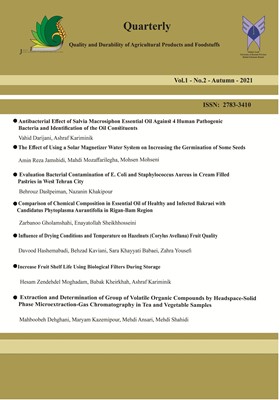The comparison of the essential oils chemical composition in healthy and infected Bakraei with Candidatus phytoplasma aurantifolia in Rigan-Bam
Subject Areas : Shelf Life of Food Products and Agricultural ProductionsZarbanoo Gholamshahi 1 , Enayatollah Sheikhhosseini 2 *
1 - M.S Student of Organic Chemistry, Department of Chemistry, Kerman Branch, Islamic Azad University, Kerman, Iran
2 - Associate Professor of Organic Chemistry, Department of Chemistry, Kerman Branch, Islamic Azad University, Kerman, Iran
Keywords: Bakraei, Essential oil, Rigan-Bam, Candidatus phytoplasma aurantifolia,
Abstract :
In this investigation essential oil chemical composition of healthy and infected Bakraei with Candidatus Phytoplasma aurantifolia from Rigan-Bam area have been studied. The branches of flower and roots of this species were collected in spring 2014 and dried in shade (at room temperature) and subjected to volatile fraction were isolated by hydrodistillation using an all-glass clevenger-type apparatus. The analysis of the essential oils were performed by using GC-MS. In the aerial organs, 39 components of essential oil of healthy bakraei were identified including linalool-L (22.7%), n- octane (11.4%), E-caryophyllene (9.8%), citronellal (8.7%), limonene (5.3%), β-bisabolene (5.3%) while, 44 components were identified in the essential oil of infected bakraei with major components including linalool-L (14.0%), n-octane (12.4%), E-caryophyllene (11.5%), citronellal (7.4%), β-bisabolene (6.9%), α-sinensal (6.0%) and limonene (5.3%). In the essential oil of underground organs in healthy bakraei, 9 components (including major component: elemol (34.3%), geijerene (11.3%), n-decane (8.0%), dictamnol (7.5 %), pregeijerene (6.0%), β-eudesmol (5.2%)) and in infected bakraie 12 components (including major component: elemol (39.5%), geijerene (16.9%), dictamnol (7.8 %), pregeijerene (5.0%). The comparison of the essential oil chemical compositions was showed that α-sinensal compound as one of the major components in infected aerial organs does not exist in healthy bakraei. Also, n-dodecane, α-santalane and seselinee as identified partial components in underground organs do not find in it,s healthy type.
1- Barrett HC, Rhodes AM. A numerical taxonomic study of affinity relationship in cultivated Citrus and its close relatives. Systematic. Botany. 1976;1:105-136.
2- Patkar AN, Desai NV, Ranage AA, Kal-ekar KS. A review on Aegle marmelos: a potential medicinal tree. International Res-earch Journal of Pharmacy. 2012;3 (8):86-91.
3- Islam R, Hossain M, Karim MR, Joarder OI. Regeneration of Aegle marmelos (L.) Corr., plantlets in vitro from callus cultures of embryonic tissues. Current Science. 1995;69:444-500.
4- Kausik B, Sumanta M, Padilam S. An eye-catching review of Aegle marmelos L. (golden apple). Pharmacognosy Journal. 2019;11 (2):207-224.
5- Fotouhi Ghazvini R, Fattahi Moghadd-am J. Growing Citrus in Iran. 4 th ed. University of Guilan press. 2016. [In Per-sian]
6- Shekari R, Rezaei K, Asadollahi S. Co-mparison of essential oil from Aegle ma-rmelos peel extracted by Microwave assi-sted hydrodistillation and Microwave ass-isted with pretreatment ultrasound. Electr-onic Journal of Food Processing and Prese-rvation. 2013;4 (1):111-124. [In Persian]
7- Nosrati B, Rajai H. Structural & phyto-chemical identification on developing pro-cesses of oil glani in fruit of bakrai (citrus reticulata citrus limetta). Journal of devel-opmental biology. 2009;1 (2):1-8. [In Pers-ian]
8- Razmi N, Jelodar G, Ebrahimi H, Bag-hshani H. Effect of Aegle marmelos fruit juice concentrate on serum glucose and lipid level and ALT/AST activities in dia-betic rats. Journal of Kerman University of Medical Sciences. 2006;13 (4):240-245. [In Persian]
9- Survimol C, Pranee A. Bioactive comp-ounds and volatile compounds of Thai bael fruit (Aegle marmelos (L.) Correa) as a valuable source for functional food ingred-ients. International Food Research Jour-nal. 2008;15:1-9.
10- Bove JM. Oman-Witches’ broom dise-ase of lime. In: Virus and virus-like dise-ases of citrus in the Near East region. FAO. Rome. 1995;217-229.
11- Carnier M, Zreik L, Bove JM. Witc-hes’ broom disease of lime trees in Oman: transmission of a mycoplasma-like organ-ism (MLO) to periwinkle and citrus and the production of monoclonal antibodies against the MLO. In: Proc. 11th Conf. IOCV Riverside. CA. 1991;448-453.
12- Salehi M, Nejat N, Tavakkoli AR, Iza-dpanah AR. Reaction of citrus cultivars to candidatus phytoplasma aurantifollah in Iran. Iranian Journal of Plant Pathology. 2005;41 (3):363-376. [In Persian]
13- Jaymand K, Rezaee MB. Essential oil, distillations apparatuses, test method of essential oil and retention indices in ess-ential oil analysis. Iranian Society of Medi-cinal, 2007;106-108.
14- Mirrza M, Sefidkon F, Ahmadi L. Nat-ural essential oils extraction, qualitative and quantitative identification and appli-cation. Research Institute of Forests and Rangelands. 1996;205.
15- Shibamoto T. Retention indices in es-sential oil analysis in capillary gas chrom-atography in essential oils analysis. Sandra P, Bicchi C. ed(s). Hutchig Verlag, Heid-elberg, New York, 1987;259-274.
16- Davis NW. Gas chromatographic rete-ntion indices of monoteroense and sesq-uiterpenes on methyl silicone and carbow-asx 2oM phases. Journal of Chromatog-raphy. 1990;503:1-24.
17- Nakamura A, Fujiwara S, Matsumoto I, Abe K. Stress repression in restrained rats by (R)-(−)-linalool inhalation and gene expression profiling of their whole blood cells. Journal of Agricultural and Food Ch-emistry. 2009;57 (12):5480-5485.
18- Katsuyama S, Mizoguchi H, Kuwahata H. Involvement of peripheral cannabinoid and opioid receptors in β-caryophyllene-induced antinociception. European Journal of Pain. 2013;17 (5):664-675.
19- Fonseca CO, Simao M, Lins IR, Cae-tano RO, Futuro D, Quirico-Santos T. Efficacy of monoterpene perillyl alcohol upon survival rate of patients with recu-rrent glioblastoma. Journal of Cancer Res-earch and Clinical Oncology. 2011;137 (2):287-293.
20- Owolabi MS, Ogundajo A, Yusuf KO, Lajide L, Villanueva HE, Tuten JA, Setzer WN. Chemical composition and bioactive-ity of the essential oil of Chromolaena odorata from Nigeria. Records of Natural Products. 2010;4 (1):72-78.
21- Lange GL, Merica A, Chimanikire M. Total synthesis of (±)-dictamnol by a free radical fragmentation/elimination sequen-ce. Confirmation of its revised structure. Tetrahedron Letters. 1997;38 (36):6371-6374.
22- Buchi G, Wuest H. Stereo selective sy-nthesis of alpha-sinensal. Journal of American Chemical Society. 1974;96(24): 7573-7574.
_||_
